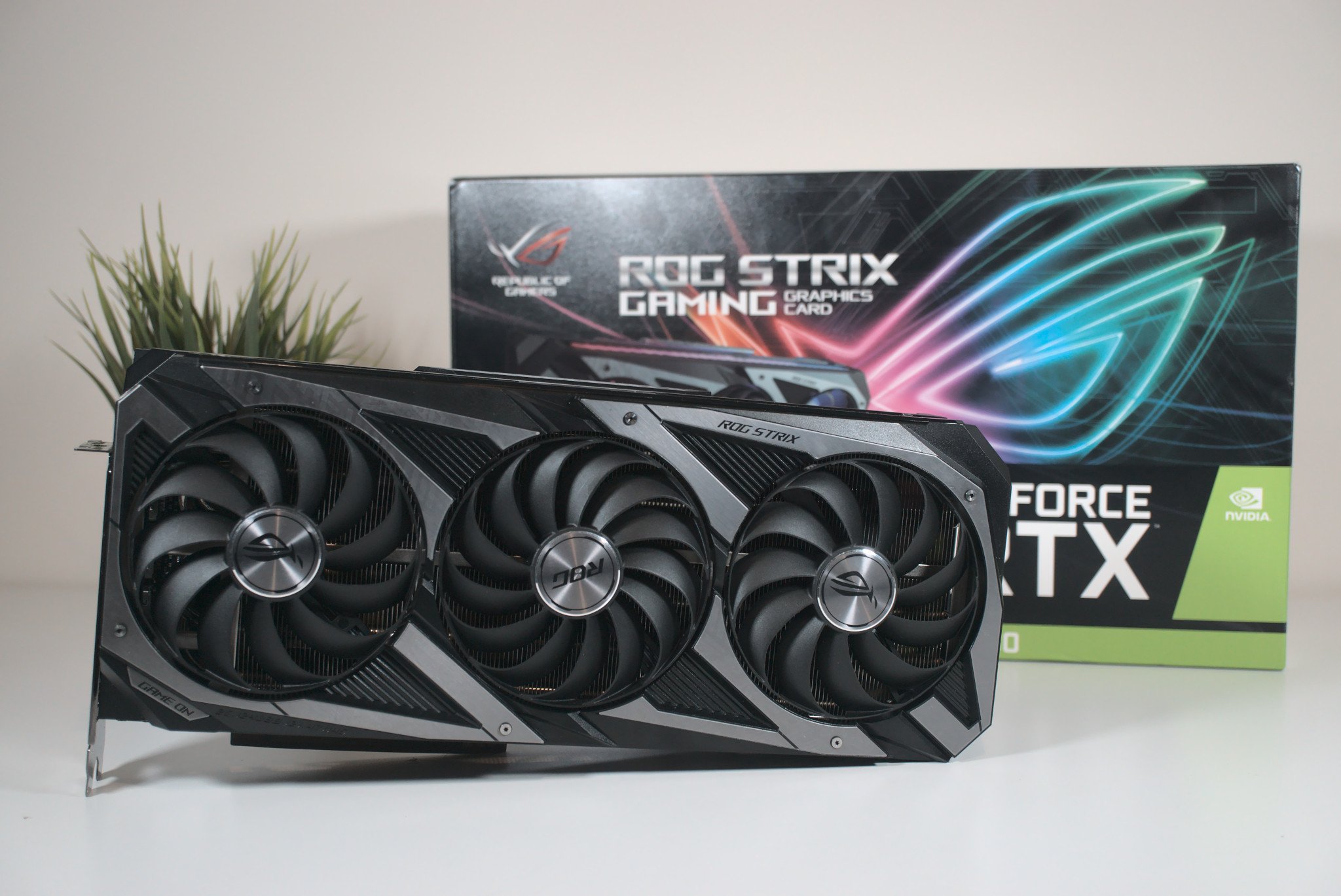Reviewing the best graphics card isn't a difficult task since most aftermarket GPUs will perform roughly the same, so long as they are running the same NVIDIA or AMD internals. Aftermarket cards like the ASUS ROG Strix GeForce RTX 3080 we have for review today rely more on cooling, overclocking, price, and design to set themselves apart.
The Strix line of graphics cards from ASUS is the company's flagship. This GeForce RTX 3080 from ASUS comes with a factory-set boost to push the card even further without you needing to touch a single setting. The NVIDIA GeForce RTX 3080 founder's edition performed seriously well and we're expecting just as much from ASUS.
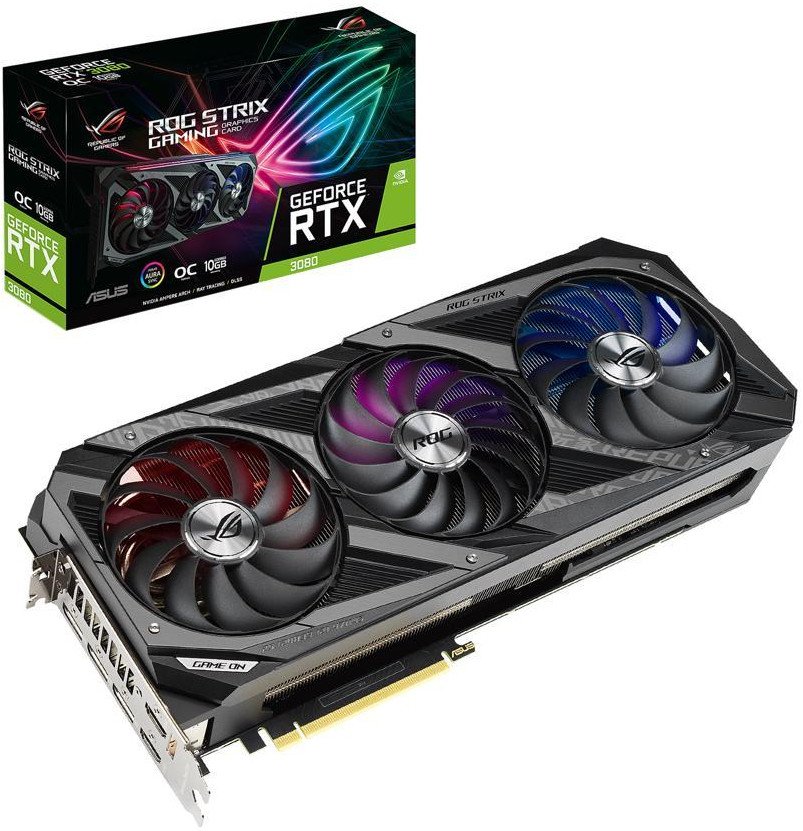
Bottom line: ASUS is used to rolling out premium high-end graphics cards and the ROG Strix RTX 3080 is no different. It offers impressive 4K gaming performance at a reasonable price, making it one of the GPUs to buy right now.
For
- Incredible performance
- Ideal for 4K gaming
- Excellent design and build quality
- Very efficient tri-fan cooling
- Full NVIDIA tech support
Against
- Requires three PCIe power connections
- High power draw
- Availability issues (like all other GPUs)
ASUS ROG Strix RTX 3080: Price and availability
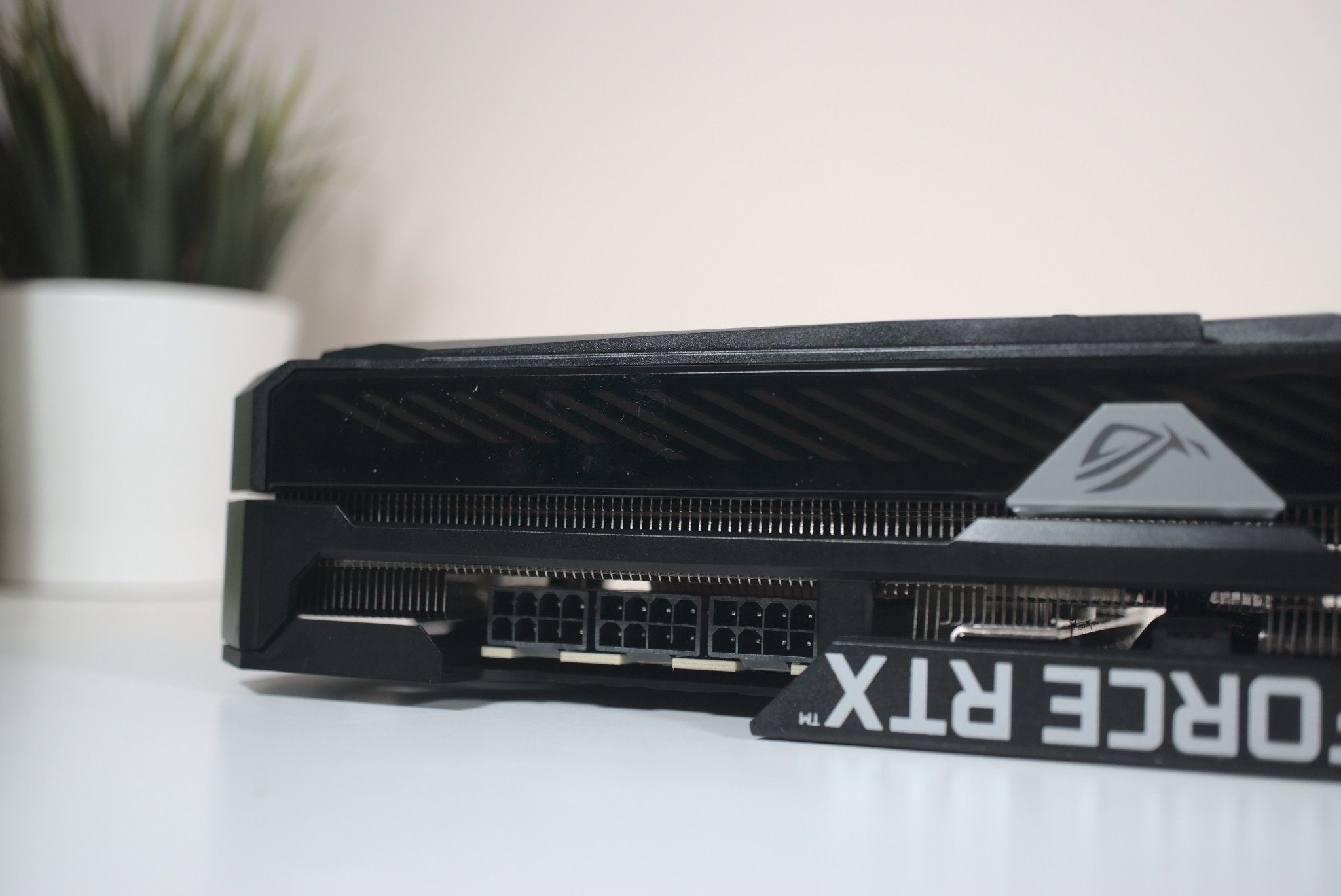
As is the case with most PC components right now, it remains difficult to locate graphics cards at MSRP. Cryptocurrency mining and the silicon shortage have played parts in driving up the price of GPUs as scalpers attempt to battle legitimate buyers in picking up what's left.
ASUS launched the ROG Strix RTX 3080 for $850, which is incredible value for 4K gaming. With the older 20-series of NVIDIA GPUs, it was only possible to unlock this level of performance by spending more than $1,000 on an RTX 2080 Ti.
ASUS ROG Strix RTX 3080: What you'll like
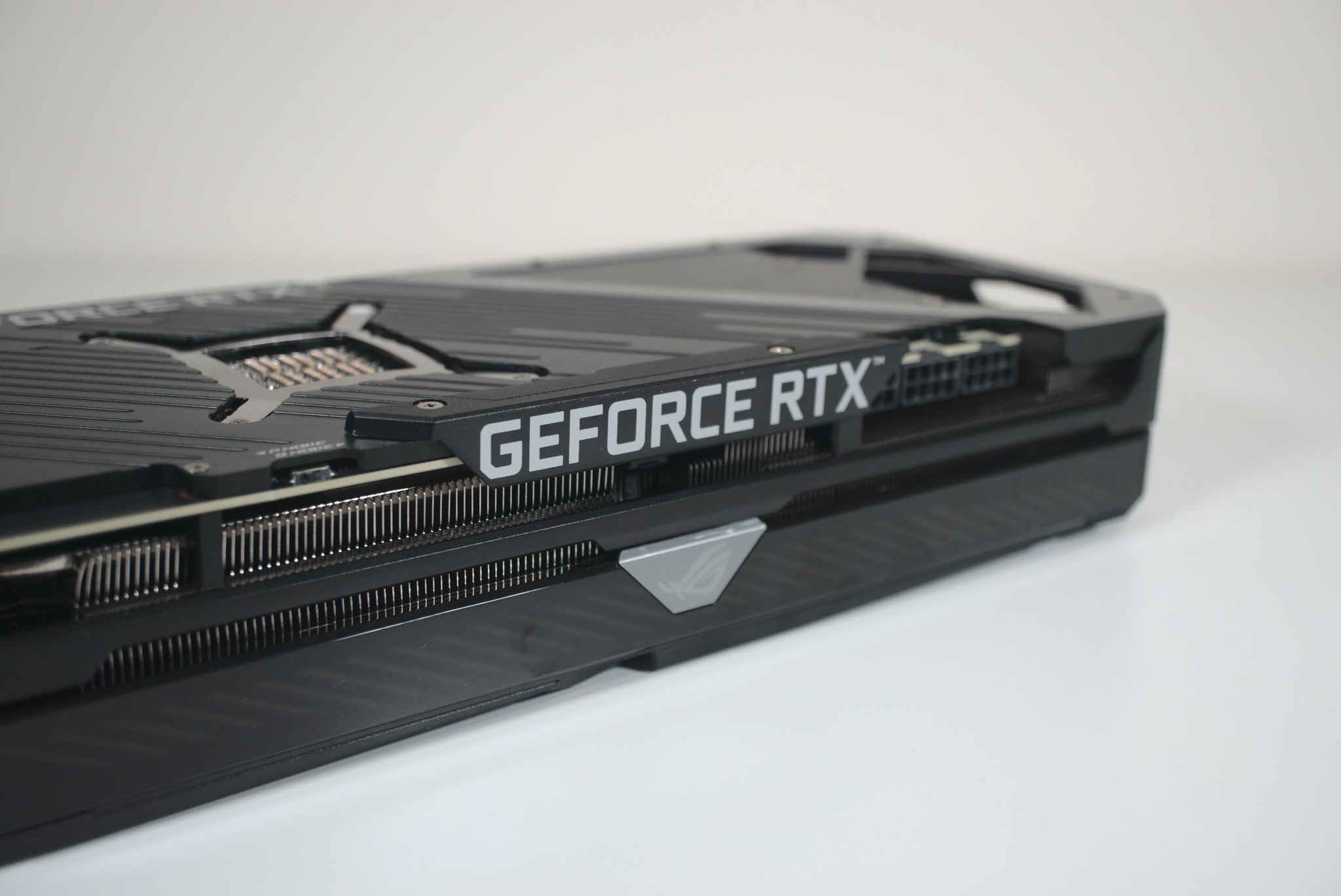
The ASUS ROG Strix RTX 3080 is a stunning GPU. Compared to the previous generation, the company has toned down the aggressive "gamer" styling a little, resulting in less RGB lighting, though you will still be able to see the card through tempered glass. It's the usual ROG Strix affair though with premium materials, a full backplate, and three large fans.
ASUS ROG Strix RTX 3080 is a serious GPU for 4K gaming.
There are three 8-pin PCIe connections for supplying enough current to the GPU. That's a lot of power and many PSUs may not have enough connectors available, especially at the lower end of the capacity scale. This is why ASUS recommends an 850W PSU as a minimum and we'd agree since this puppy can draw up to 320W alone.
Keeping everything cool, ASUS took a few cues from NVIDIA's reference design with the passthrough of air. You'll see the same feature here with this card. The right fan will actually blow air all the way through and out the top, helping to reduce blowback. The heatsink is huge with full copper heat pipes.
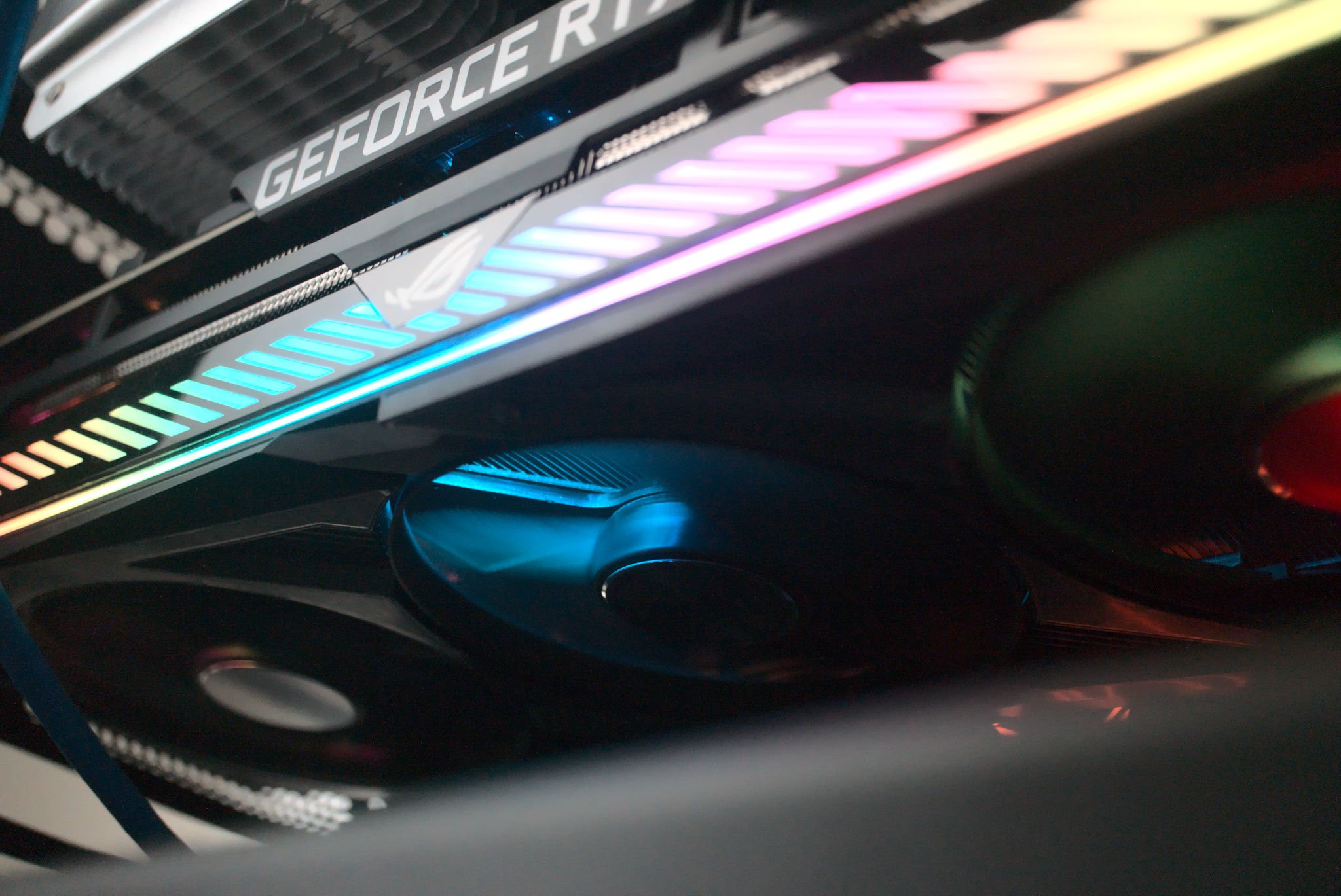
Compared to the base NVIDIA RTX 3080, which we reviewed favorably for its performance, the RTX 3080 from ASUS is able to boost far higher at 1935MHz instead of 1710MHz. This results in overall better performance, allowed by those three large fans on the 2.9 slot GPU. You also get all the usual specs with the NVIDIA RTX 3080, including 8,704 CUDA cores, 68 Ray Tracing cores, and 272 Tensor cores.
| Category | ASUS ROG Strix GeForce RTX 3080 |
|---|---|
| Shader cores | 8704 |
| Core clock | 1440MHz |
| Boost clock | 1935MHz |
| GPU | GA102 |
| Memory | 10GB GDDR6X320-bit bus width |
| Memory clock | 19Gbps |
| Memory bandwidth | 760GB/s |
| RT cores | 68 |
| Tensor cores | 272 |
| Transistors | 28.3 billion |
| Node | Samsung 8nm |
| Architecture | Ampere |
| TDP | 320W |
| Ports | 2 x HDMI 2.13 x DisplayPort 1.4a |
| Power connector | 3x 8-pin PCIe |
If you'd like to learn more about the Ampere architecture from NVIDIA and how that compares to the older Turing that we saw with RTX 20-series cards, I highly recommend you check our RTX 3080 founder's edition review for in-depth detail. Cutting a long story short, NVIDIA made some changes to how it handles floating-point and integer operations that unlocked vast amounts of performance.
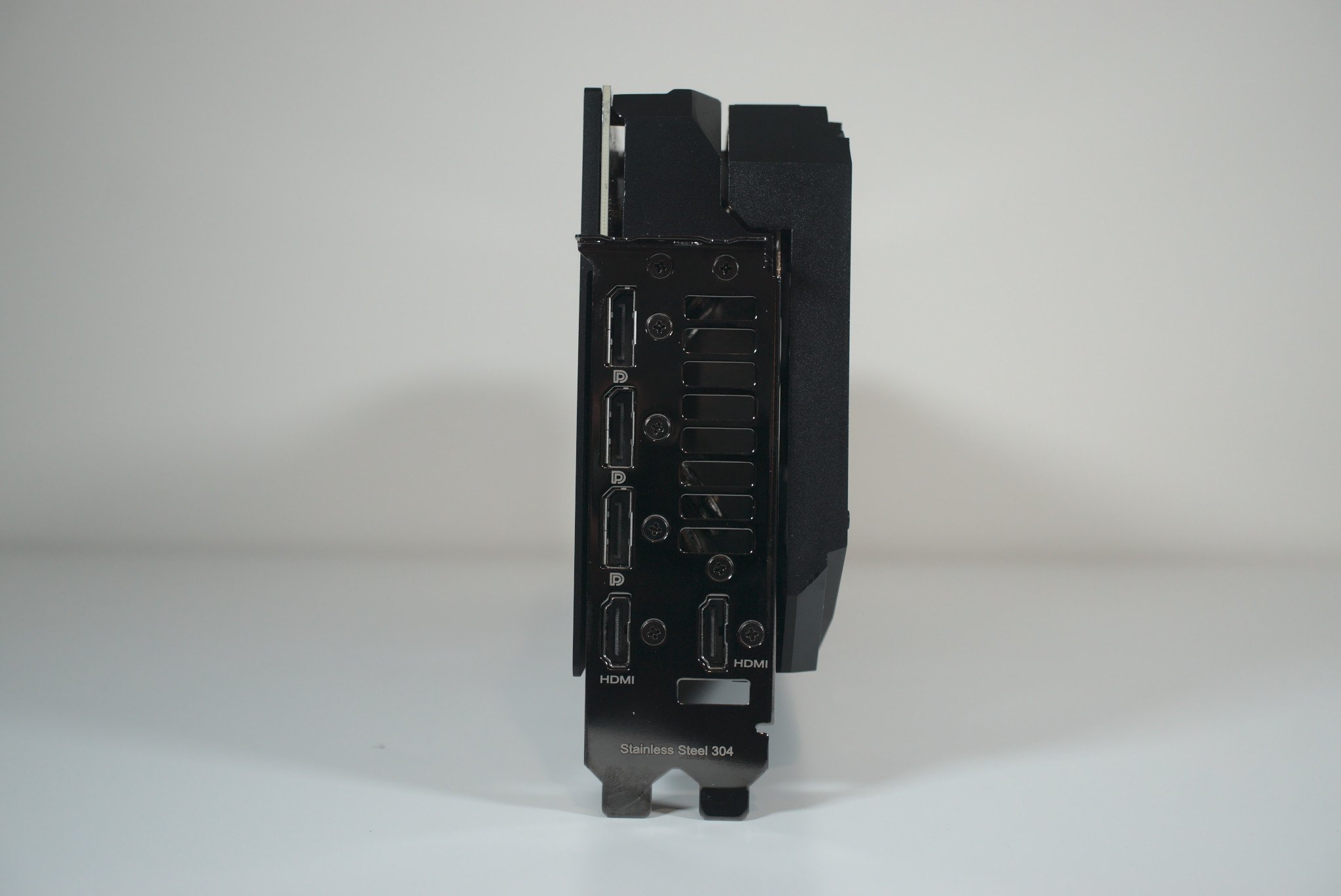
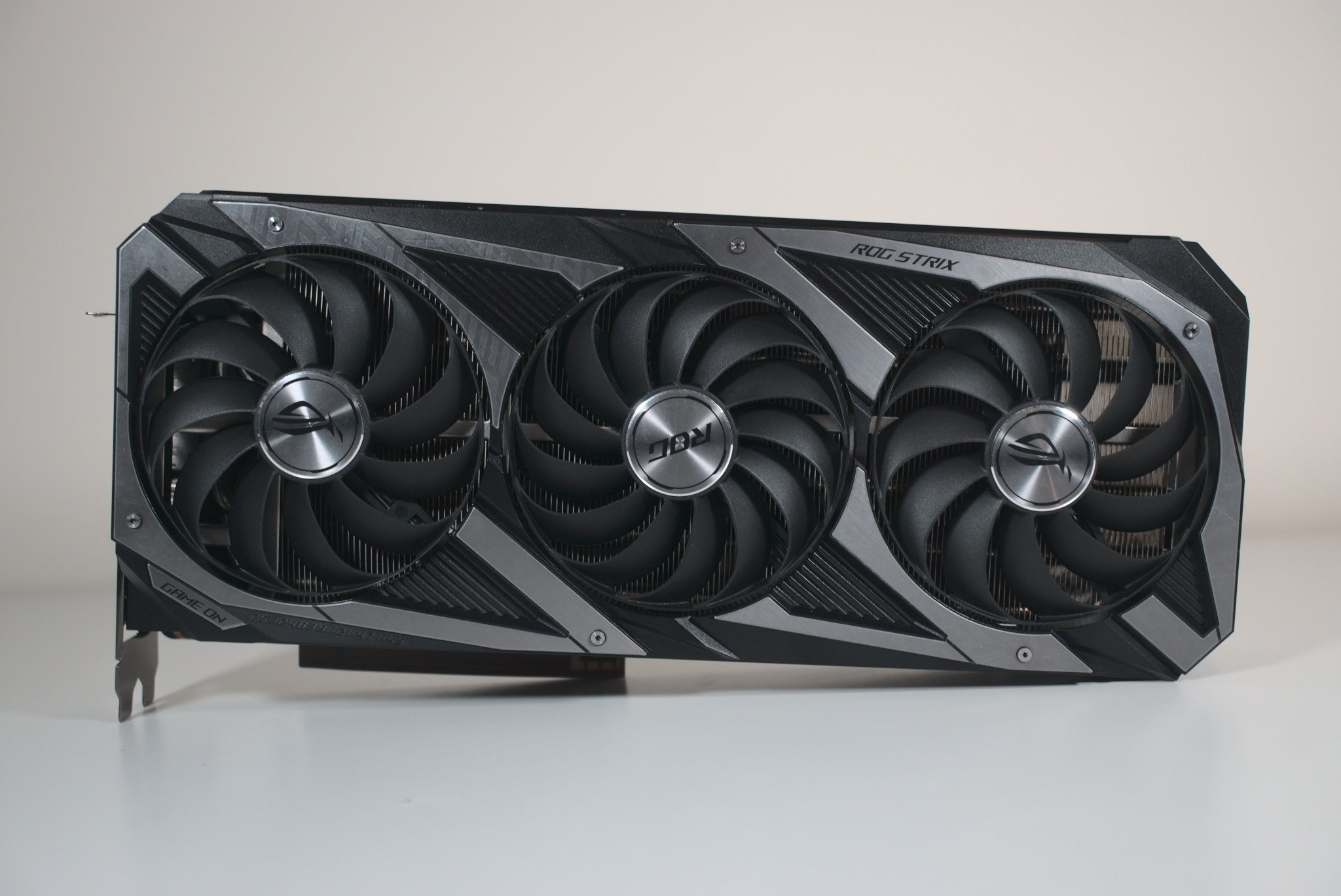
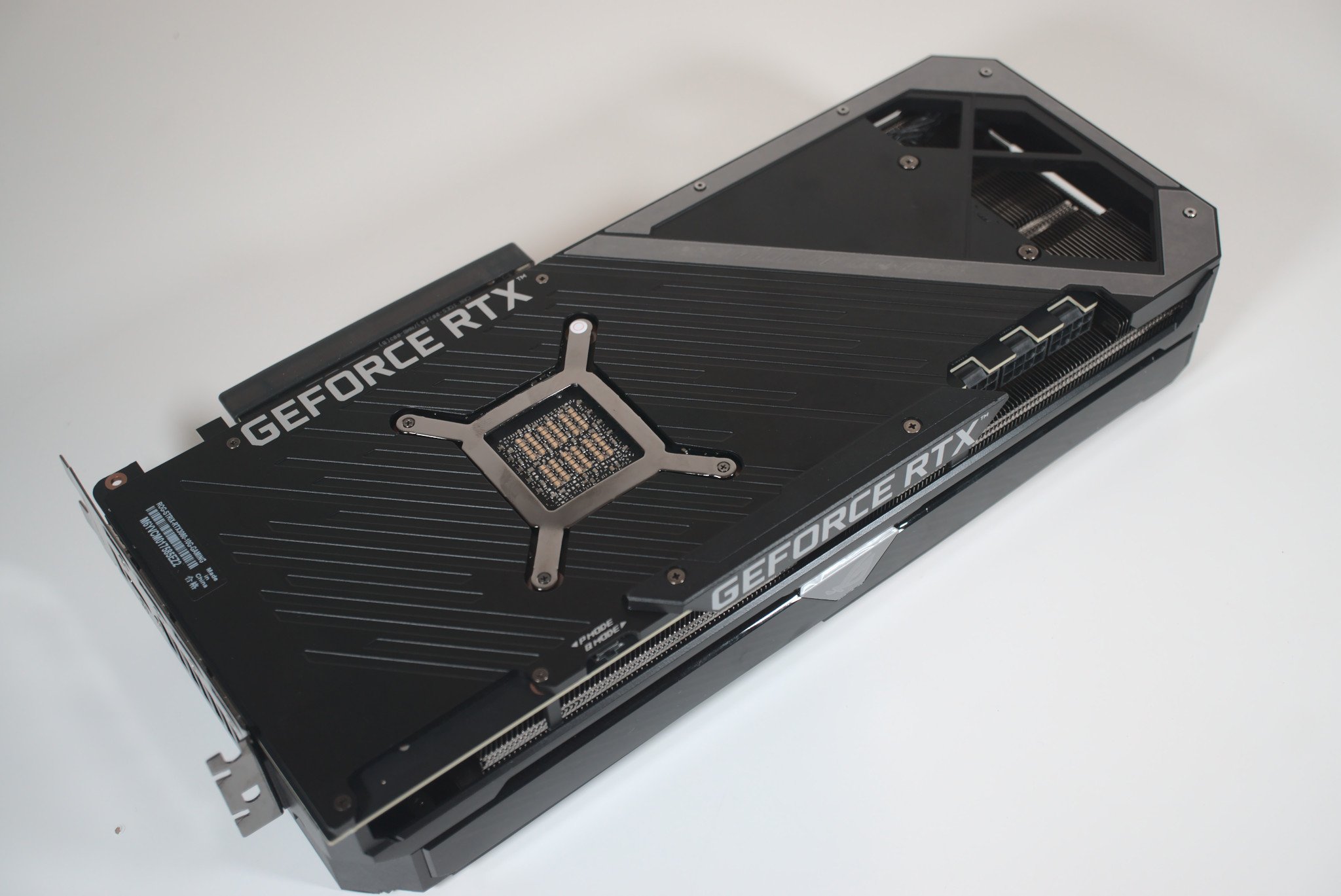
This is a 4K-capable GPU for gaming and there are plenty of ports to choose from. On the back, you'll find two HDMI 2.1 ports and three DisplayPort 1.4a ports. But really, as aforementioned, reviewing aftermarket graphics cards is strange ground as most aftermarket cards will rock the same specs, aside from clock speeds and perhaps memory.
| Category | Hardware |
|---|---|
| CPU | AMD Ryzen 9 5950X |
| GPU | ASUS ROG Strix GeForce RTX 3080 |
| Cooling | NZXT Kraken X73 |
| Motherboard | ASUS X570 Gaming-E |
| Memory | 32GB Corsair Vengeance Pro |
| Storage | 1TB Sabrent Rocket 4 |
| PSU | be quiet! Dark Power 12 1200W |
Because of this, we expected a lot from the ROG Strix RTX 3080, especially given we managed to push games to high settings at 4K with NVIDIA's founder's edition. There was no surprise once the test rig was fired up. The RTX 3080 from ASUS performed extremely well at both 1440p and 4K, making it a compelling option if you have a monitor at either resolution.
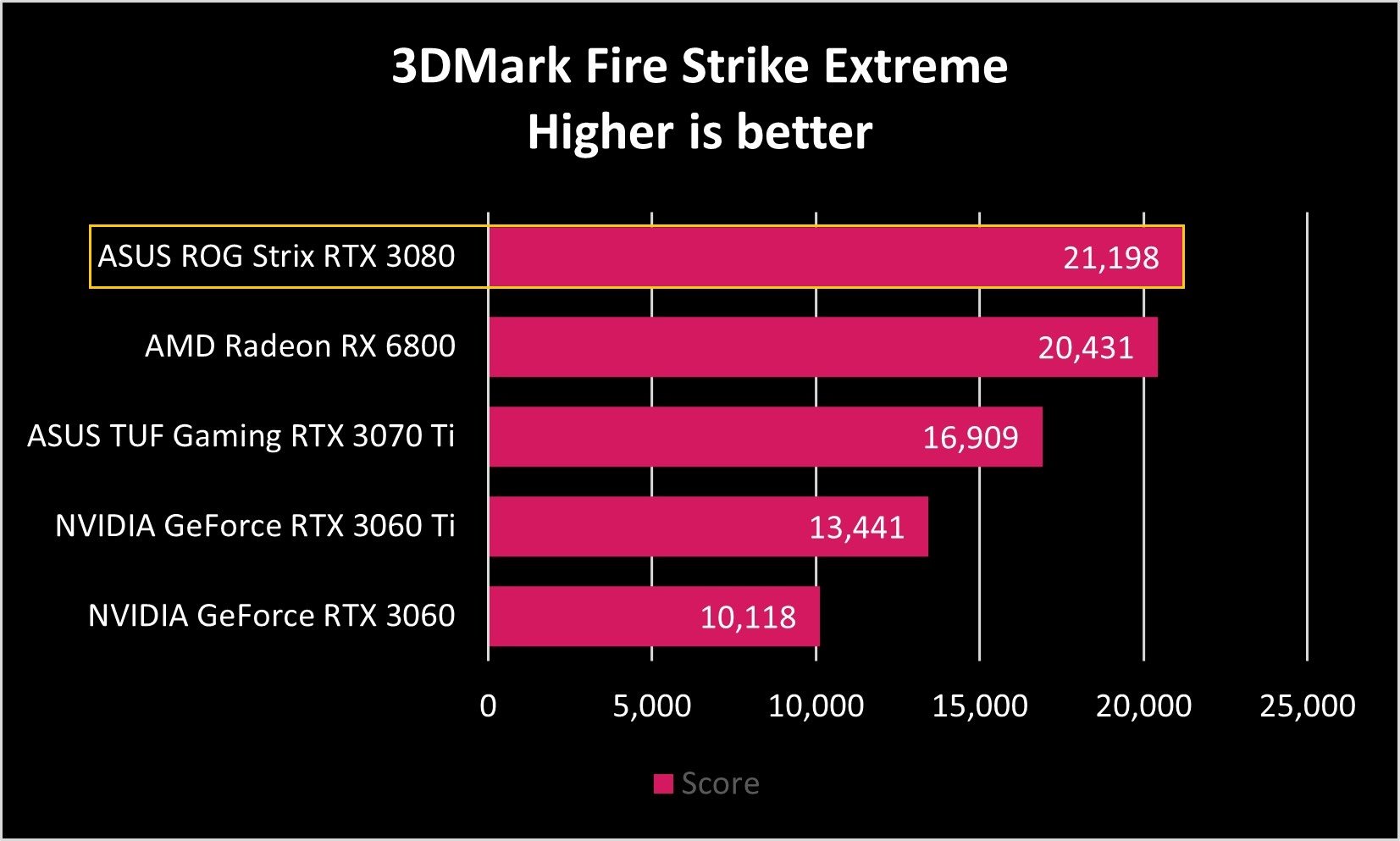
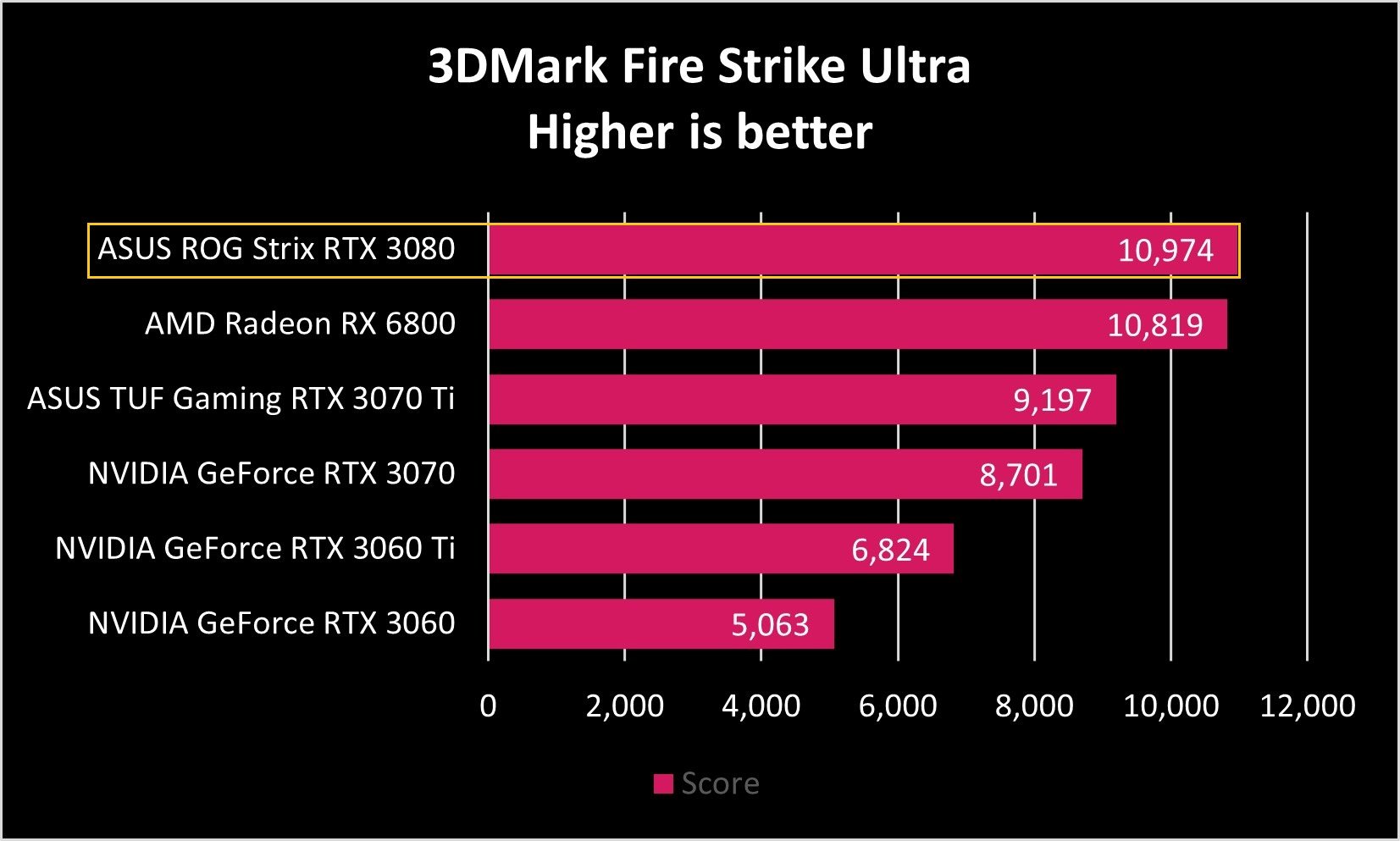
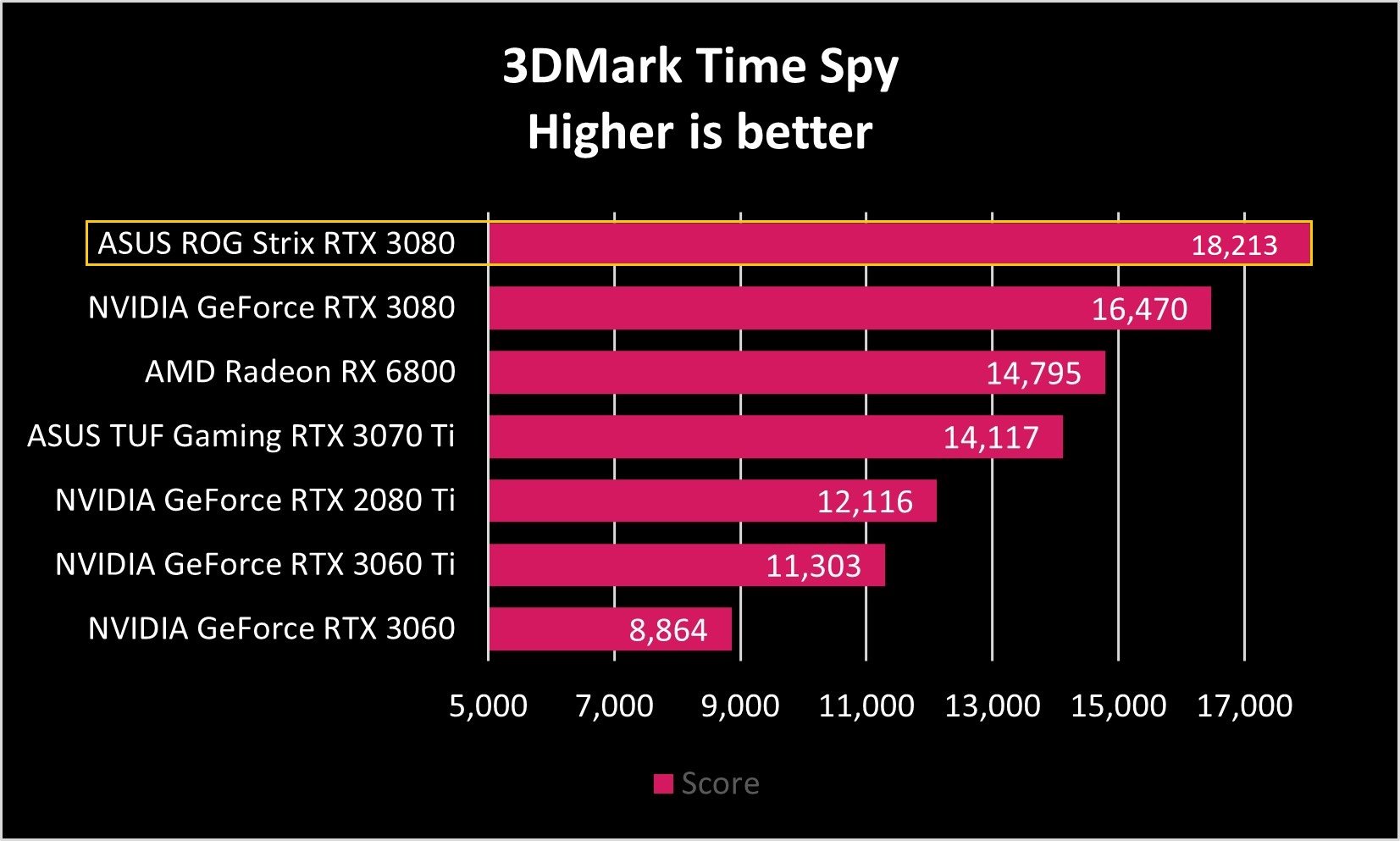
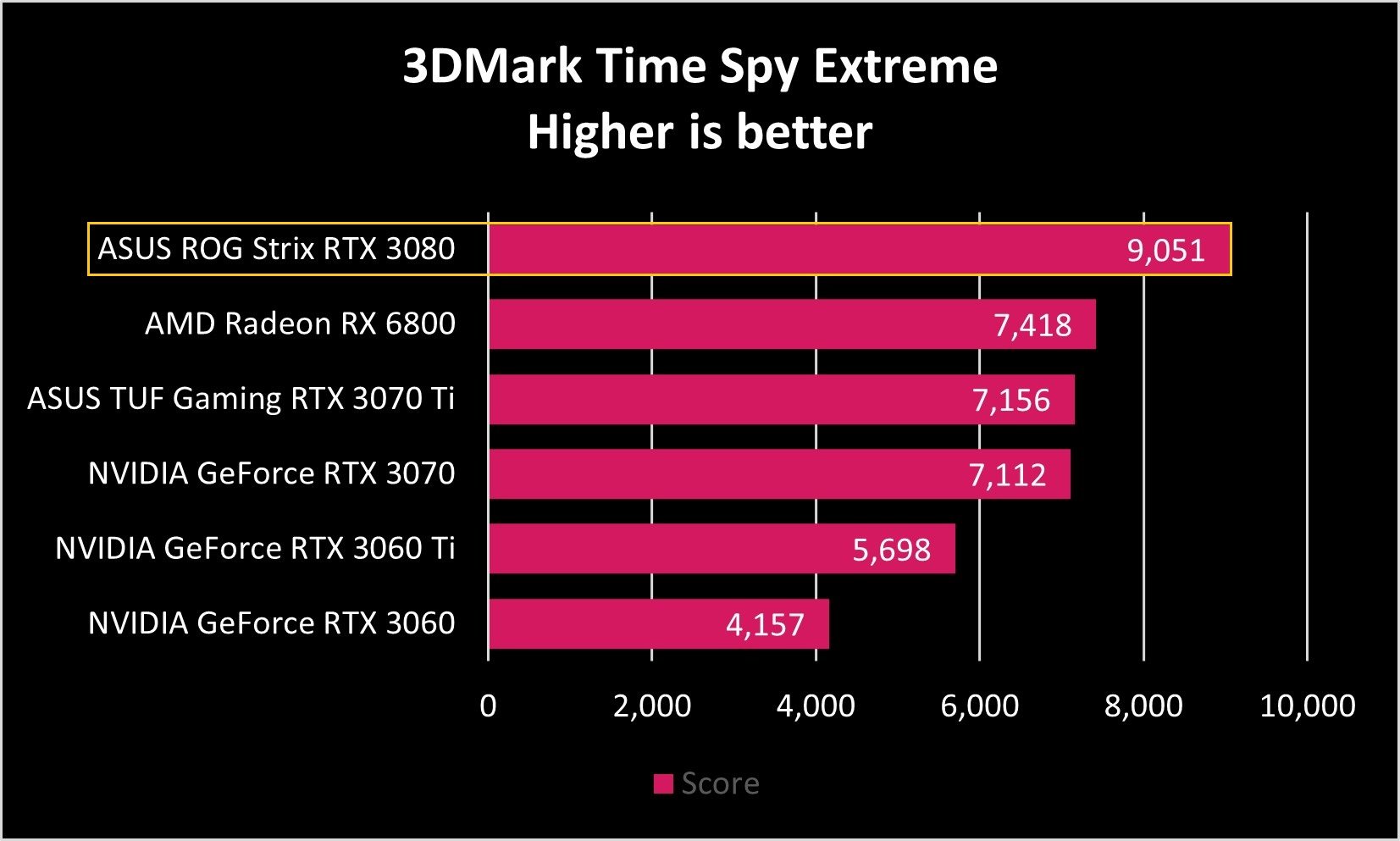
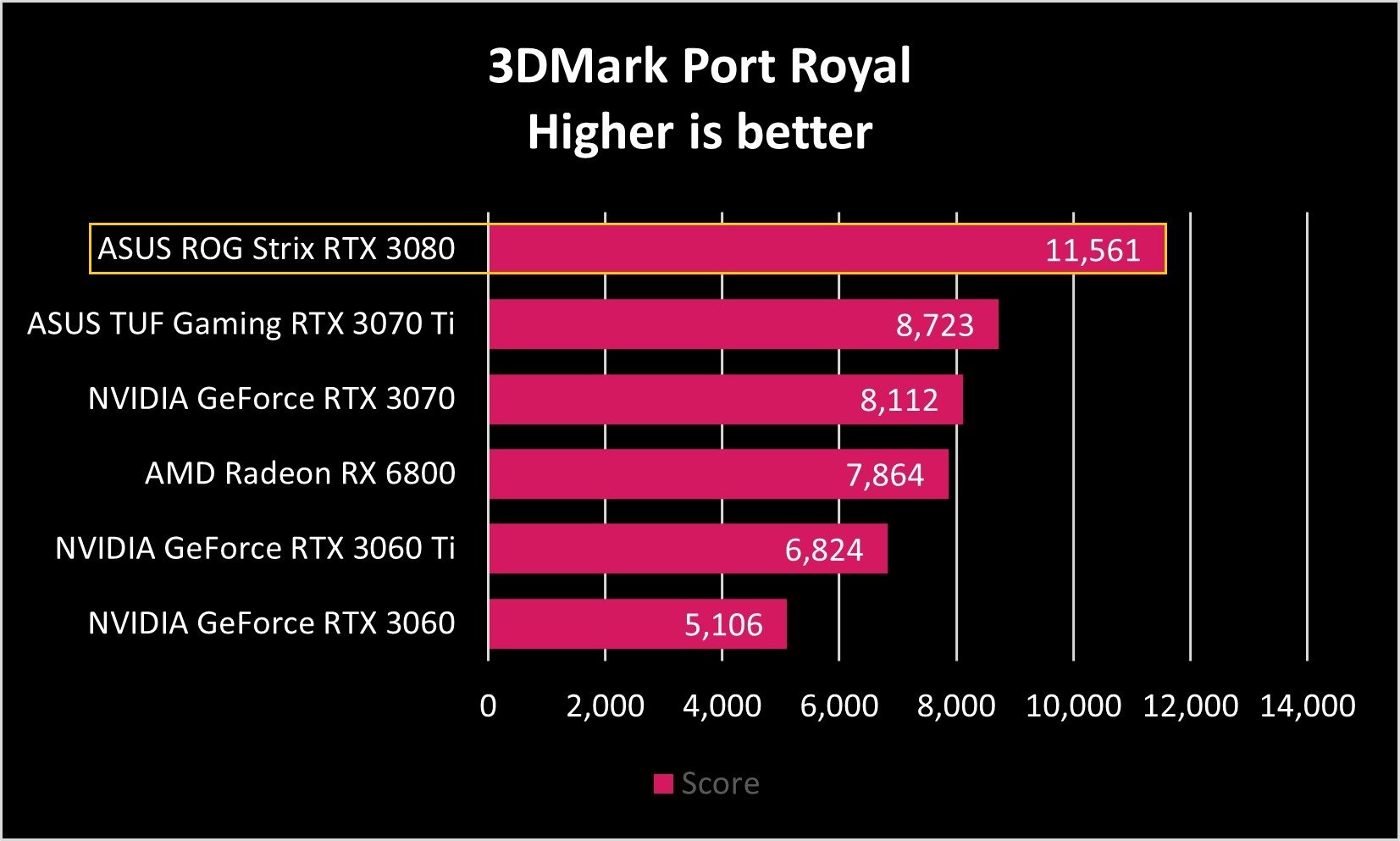
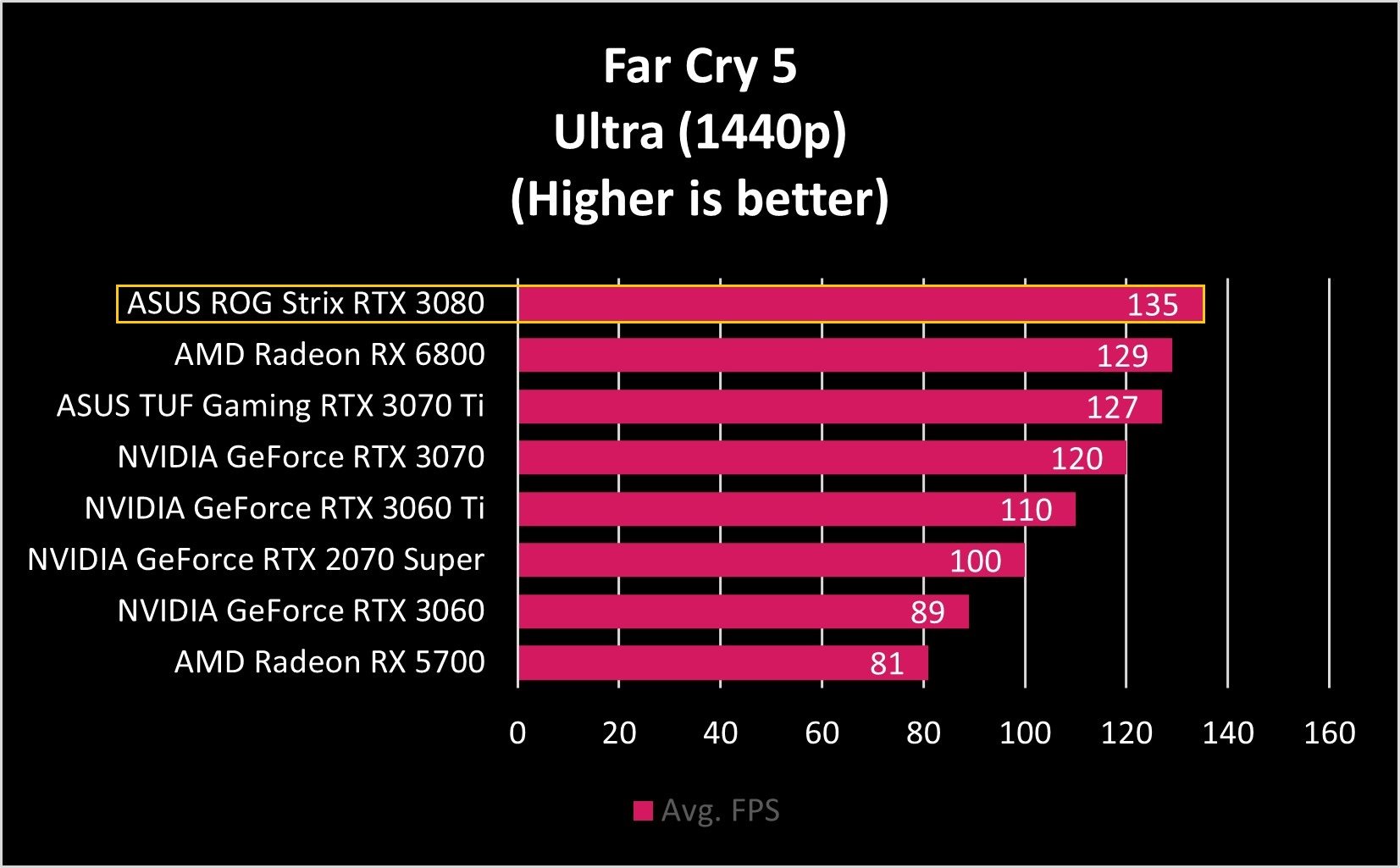
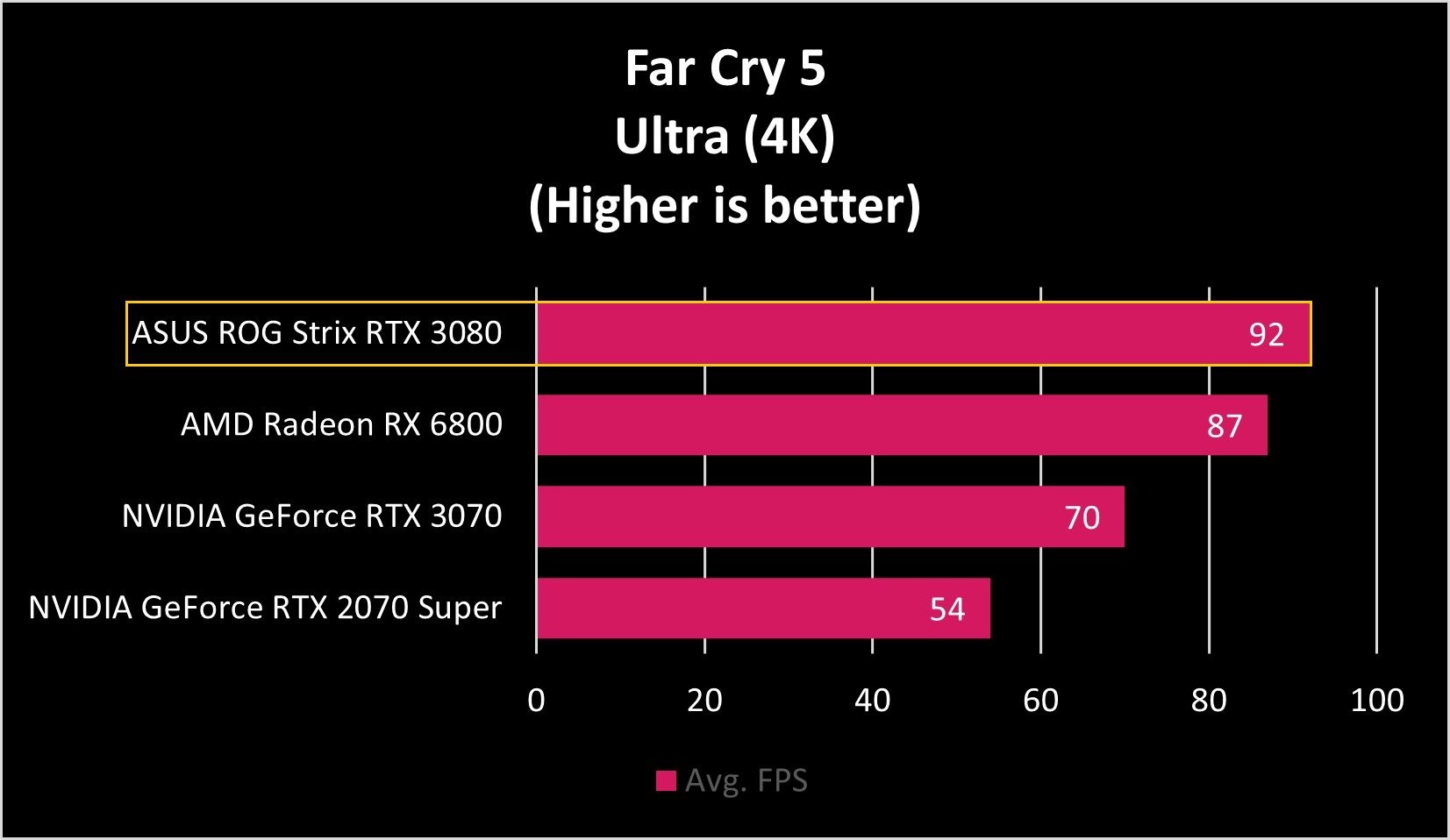
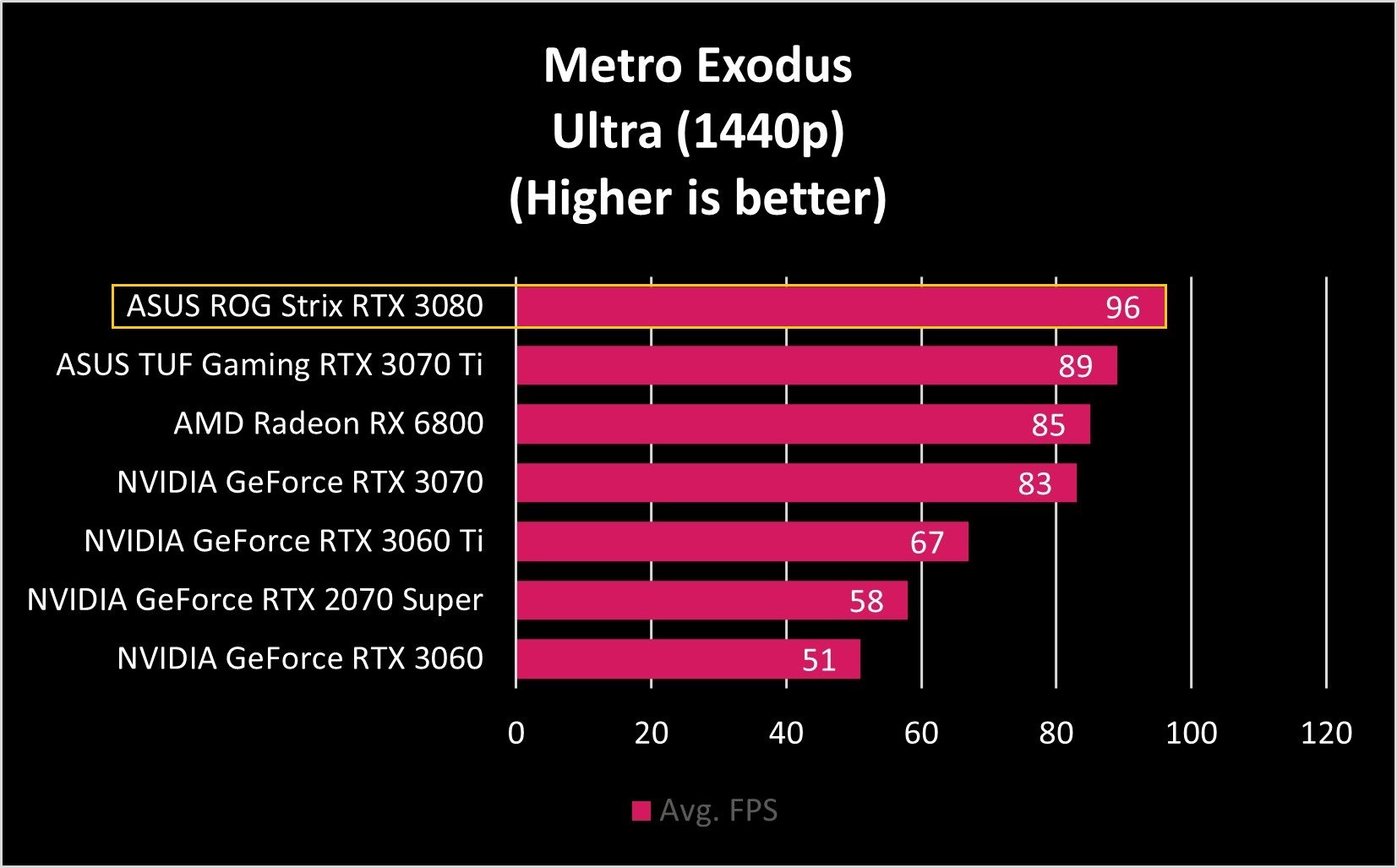
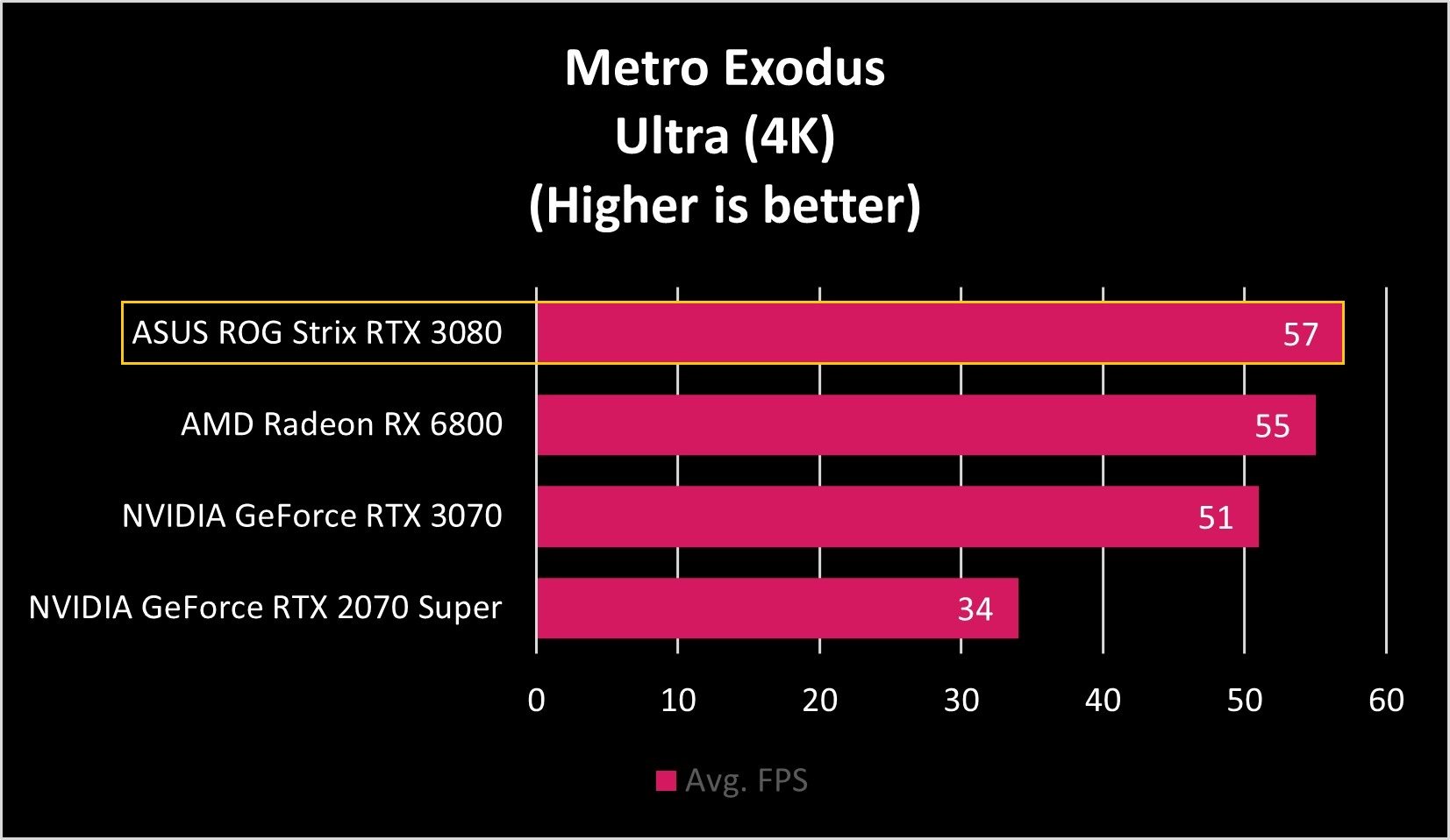
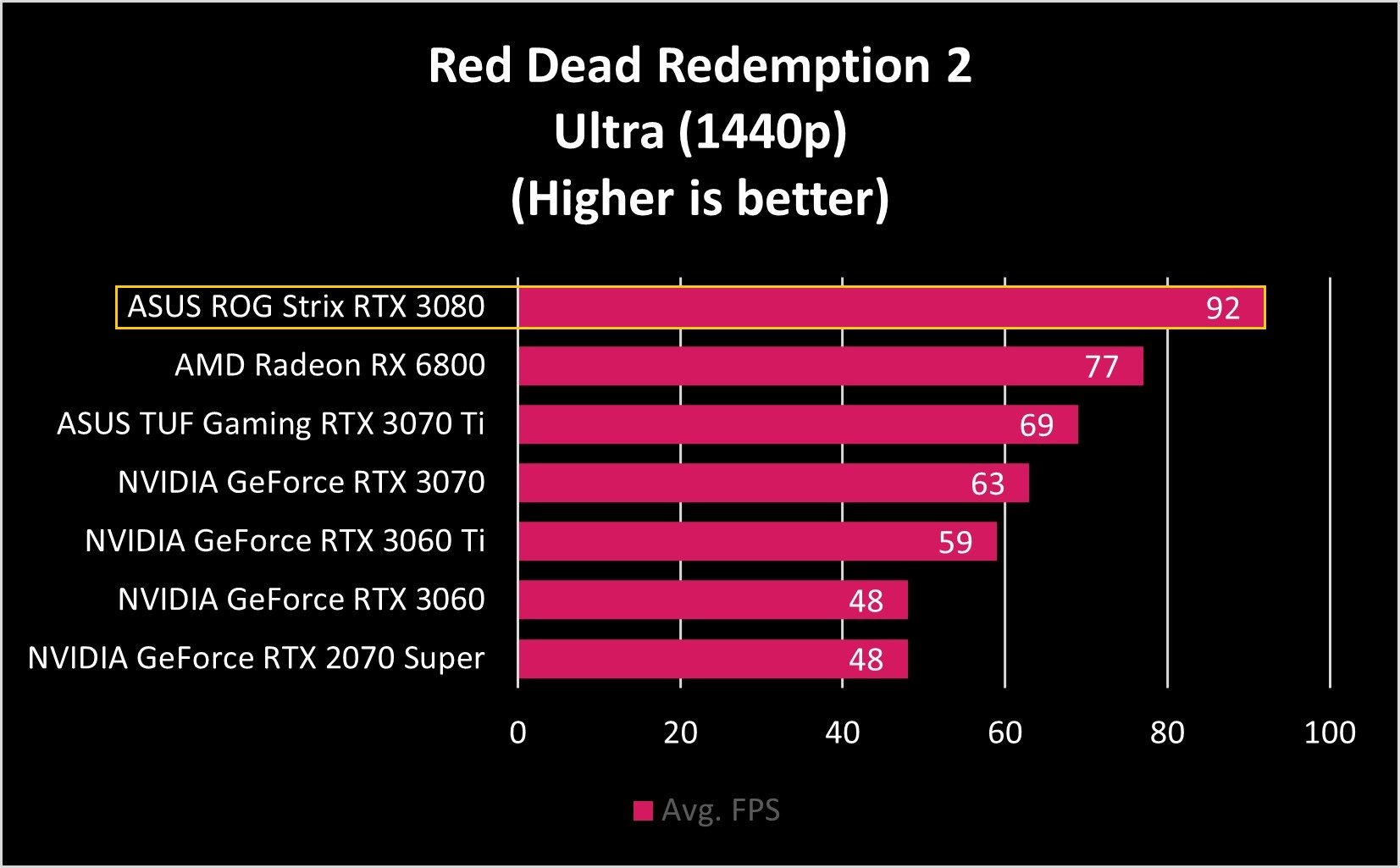
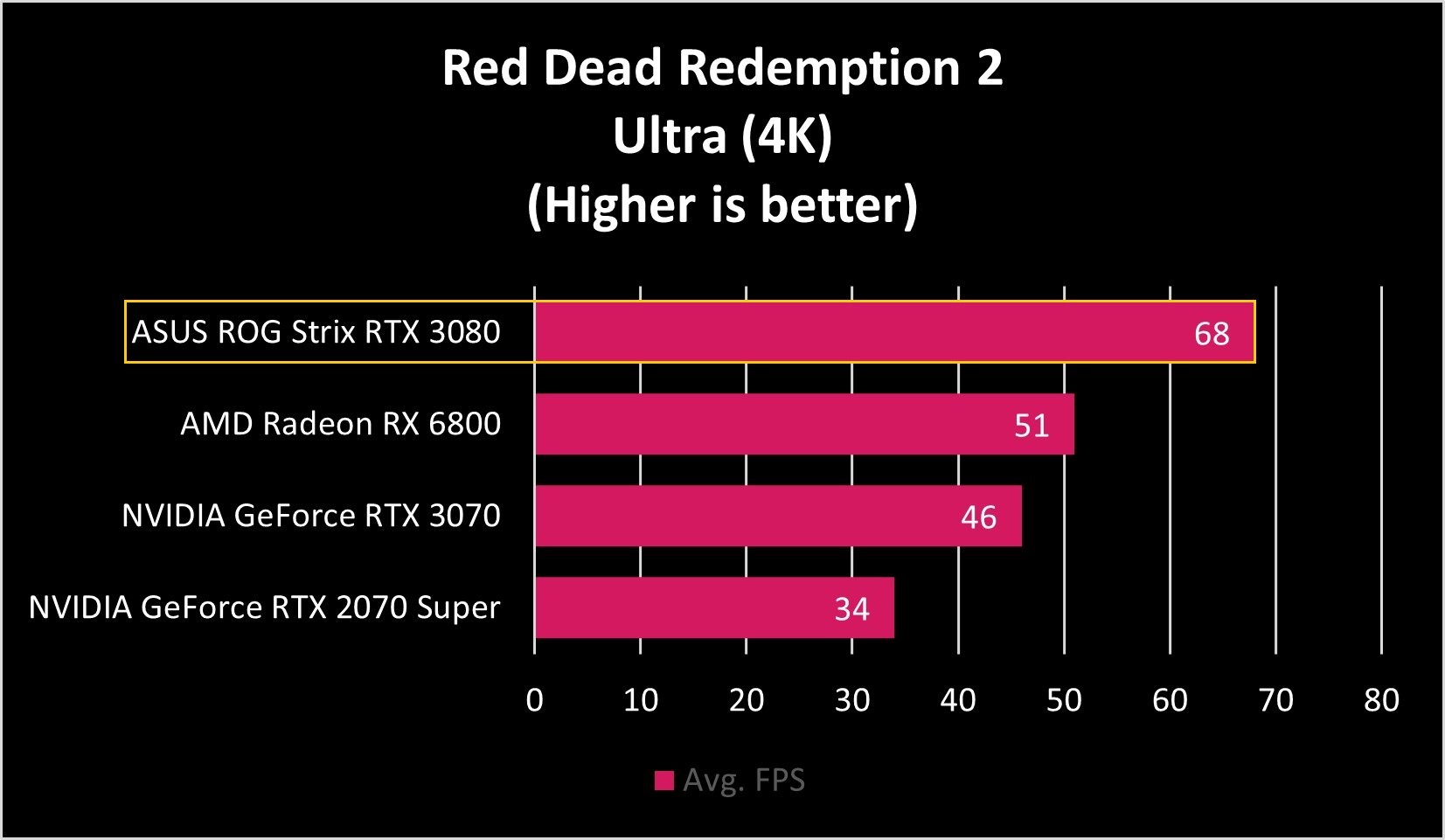
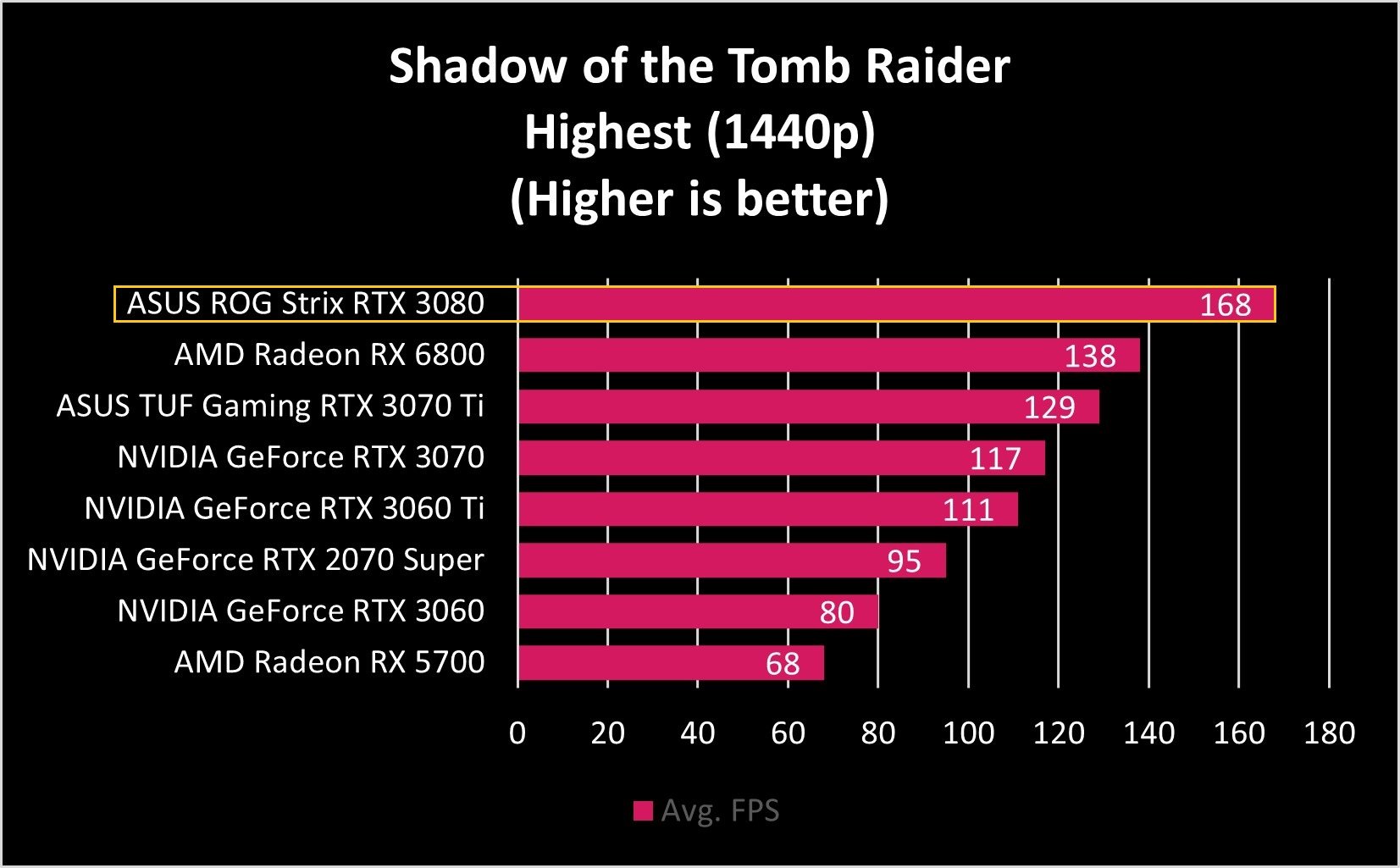

At both 1440p and 4K, you'll encounter no issues playing the latest and most demanding PC games. The GPU scored high in benchmarks and other synthetic tests and temperatures were well within acceptable ranges (never really surpassing 70C) when under load. Overall, this is some serious performance at a good price.
ASUS ROG Strix RTX 3080: What you'll dislike
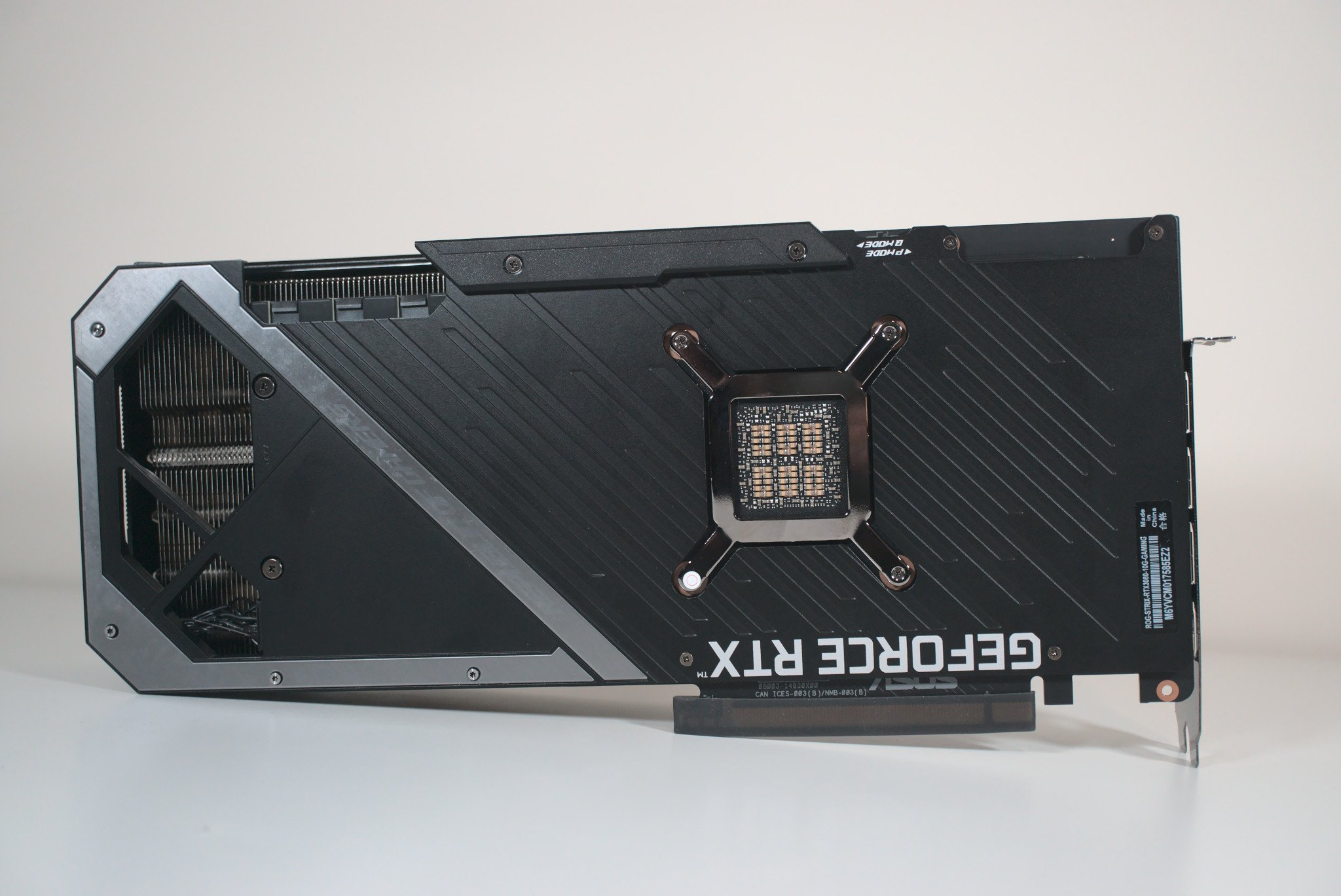
There's not really much to dislike about the ASUS ROG Strix RTX 3080. It's a long GPU, needing to cram on those three fans to keep the NVIDIA GPU cool. At 320mm long, you'll need to ensure you have enough space inside your PC case for the GPU. If you're using an AIO cooler with a front-mounted radiator, you may encounter an installation issue with a smaller chassis.
Your PSU will also need to have three available PCIe connections to supply enough power to the card. ASUS recommends a power supply with a capacity of around 850W. We'd also recommend this amount to be safe and most units in this range or above should come with enough PCIe cables. Performance-wise, we have no complaints with the ASUS ROG Strix RTX 3080.
ASUS ROG Strix RTX 3080: Competition
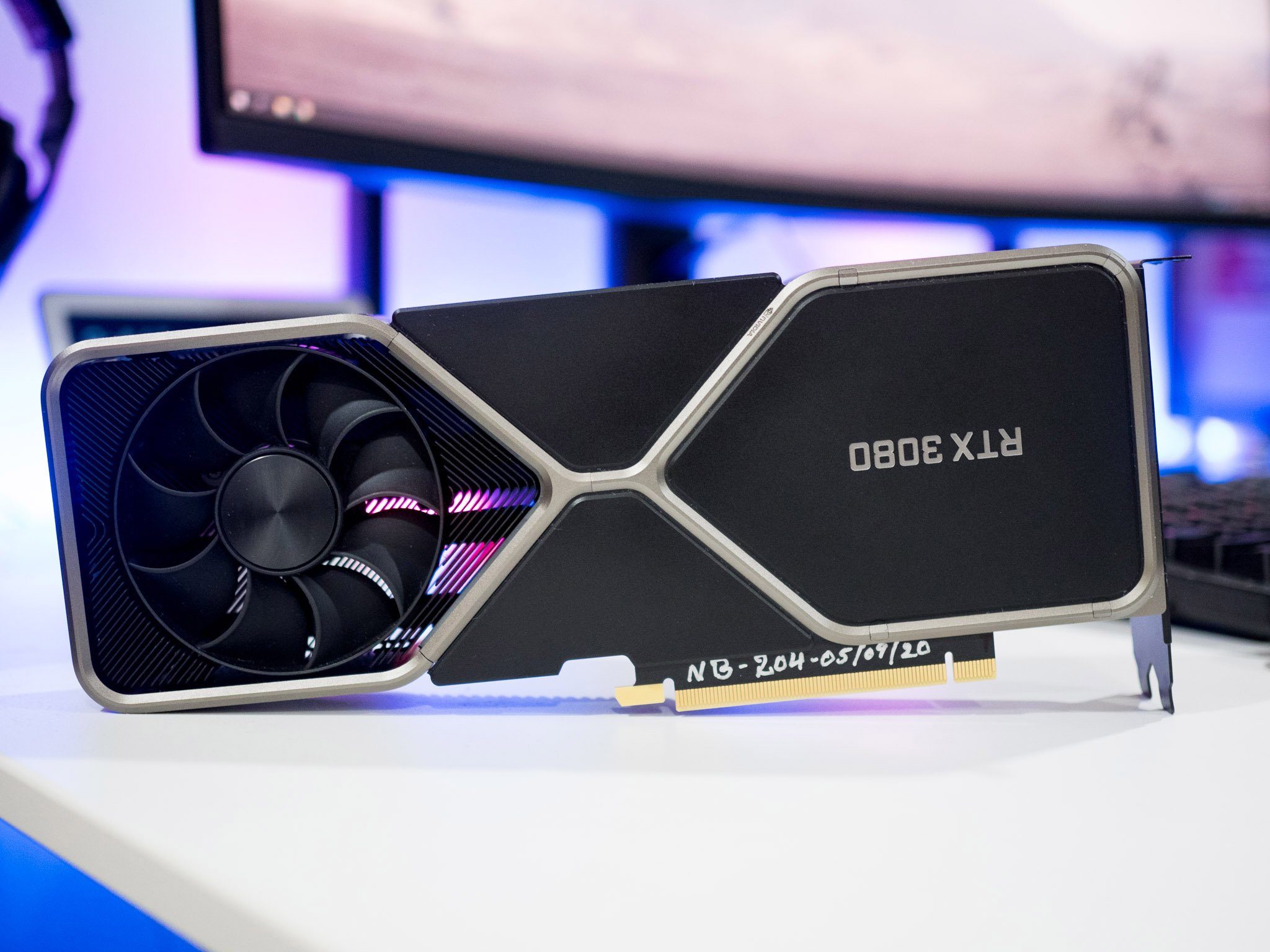
The RTX 30 series from NVIDIA delivers serious performance gains over the RTX 20 series, making the RTX 3080 a worthy recommendation for anyone with a 10- or 20-series GPU. The RTX 3080 offers up to 70% gains compared to the older RTX 2080 at the same price, and that's just for the NVIDIA reference cards.
For aftermarket RTX 3080s, there are plenty to choose from, including a few from ASUS too. The other ASUS cards aren't as capable and do cost a little less, but compared to other aftermarket vendors, it really comes down to price, availability, design, and cooling. Most of them will perform as well as this GPU.
If you were to want a competing AMD option to the RTX 3080, it would be the AMD RX 6800 XT with 72 compute units, 16GB of GDDR6 RAM over 256-bit and 16Gbps clock for a total bandwidth of up to 512GB/s. We reviewed the AMD RX 6800 favorably and the XT version offers a little more performance to hit 4K resolutions.
ASUS ROG Strix RTX 3080: Should you buy it?
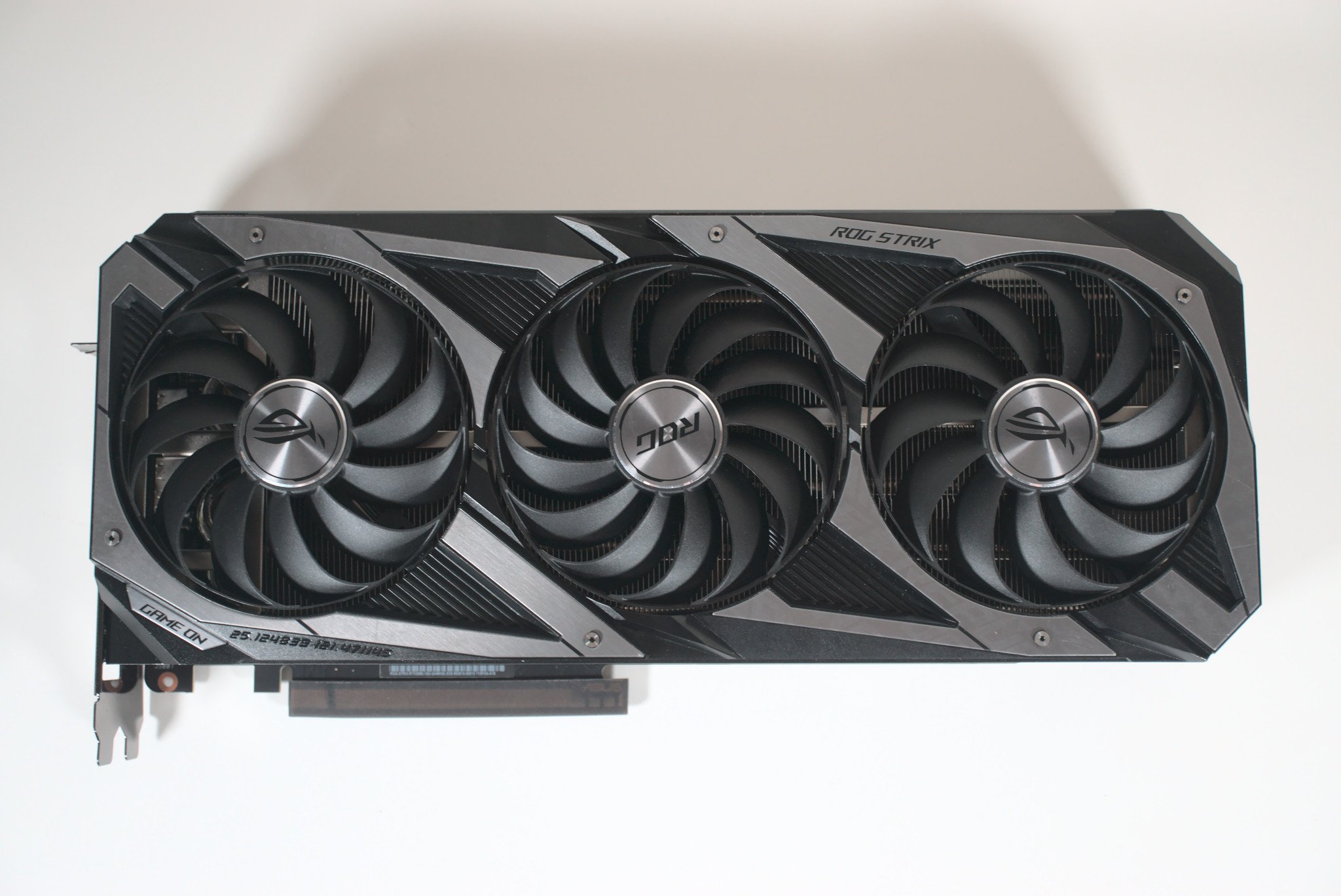
You should buy this if ...
- You want excellent 1440p and 4K performance
- You have an older 10-series NVIDIA GPU
- You want to keep your next GPU for many years
You shouldn't buy this if ...
- You don't want to wait for better prices
- You don't have a 4K monitor
- You don't have upwards of $1,000 to spare
Unfortunately, for most people, GPUs are still way too expensive right now. The silicon shortage and crypto mining demand are still making it difficult to locate stock at reasonable prices. This ASUS ROG Strix RTX 3080 is no different. The MSRP is $850, and you should not fork out more than $1,000 at the very most if you really need one now.
If you were to pick one up at the original asking price, the RTX 3080 is an incredible GPU. What ASUS managed to add on top of the reference design from NVIDIA is astounding for in-game performance. The design is subtle but bold with effective lighting. The cooling is more than enough for long gaming sessions, and the stock overclock is excellent and stable.
It's a little staggering that we're now at a point where you can buy a very capable 4K graphics card for $850. Both NVIDIA and ASUS have done stellar jobs on their fronts that result in one of the best graphics cards available. It's a great choice for anyone wanting to buy a GPU and not have to replace it for many years to come, so long as you have a 4K monitor to enjoy it.

Rich Edmonds was formerly a Senior Editor of PC hardware at Windows Central, covering everything related to PC components and NAS. He's been involved in technology for more than a decade and knows a thing or two about the magic inside a PC chassis. You can follow him on Twitter at @RichEdmonds.
